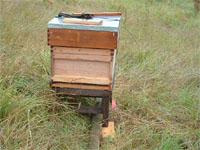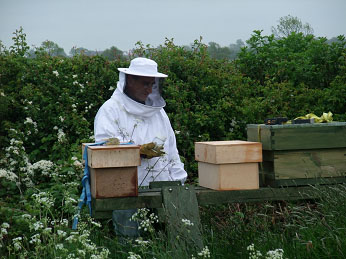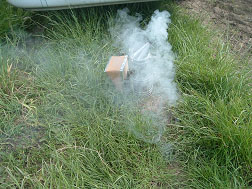Bee Friendly! – Part 1

Paul Hirons, beekeeper, takes us on a trip to his hive. In Part 1 he tells us something about the bees themselves, and about getting kitted up for the visit …
It’s a nice sunny day, early May, the temperature is above 10 degrees and there is little wind. It is mid afternoon, bees are flying and I’m going to inspect my hive.
In a hive there are three types of bees. There is the queen, the drone and the worker. There is only one queen and only the queen will lay eggs. The drones are the males, do no work and are only there to mate with queen. There are the workers who are all female, work very hard and number thousands. A good colony will consist of one queen, 300 to 3000 drones and 20,000 to 40,000 workers.
Bees have four stages of development. The queen lays an egg in a cell, which becomes a grub or larvae. This then goes into a pupa state and changes into the final bee. The queen takes 16 days to go from laid egg to emerging queen. A worker takes 21 days to go from an egg to an emerging worker. The drone takes 24 days to go from an egg to an emerging drone.
The queen determines the composition of a colony. The queen will give the colony its temperament or its mood. Changing the queen can turn an aggressive hive into a good-tempered one. Within six weeks all the bees in the colony will have changed to the new temperament. Please don’t quote me on that – I’d have to look at the books for the life cycles of the bees to give an accurate figure!
Before I end up telling you stuff you don’t want to know about beekeeping, why don’t you join me on a visit to one of my hives … a few hours in the life of a beekeeper – life behind the veil.
Beyond The Veil
Sitting around in the sun for half an hour to get used to a brand new bee jacket with the hood on may not sound like fun. It is sometimes hot and it can sometimes feel a bit claustrophobic. I do ask anyone new to beekeeping to get used to their jacket and having a veil on your face. I use the Father Brown-type bee jackets with a big wide-brimmed veil suspended from a big round hat. I don’t care for the hoody type jacket because I don’t like the jacket on my neck and cotton resting on the back of my head.
I still practice getting my gloves on with my bee jacket hood up. That’s it! Put them on and take them off. I do it still. Mainly because I pinch the Missus’s cleaning gloves and she blinking buys the smaller size! She knows I’m going to take them! I’m using the blue household gloves that are thicker than the yellow Marigolds and don’t tear so easily. I do have suede gloves with gauntlets that reach up to my elbows. I’ve got four pairs – all from well meaning friends that buy them as gifts! I use the rubber ones though because I like to be able to feel what I’m doing with my fingertips. I can do that in my blue Tesco rubber gloves ...
Now Where is That Bee Brush and That Hive Tool?
I undo the zipper on my hood and let it sit on my shoulders and collar. I take my smoker and open the hinged top and light it up. I select three rolled up loo roll centres that I light with my cooks’ matches and as they catch fire I drop them in the smoker and start pumping the smoker bellows. I pop in some dry twigs and some rotten wood I collected from a fallen tree; I’ve knocked it against the tree to remove all the insects. I’ve found a fallen tree and go back there to fill a black bin bag with dry wood.
I gently pump the bellows and watch for flames at the top of my smoker so I know the wood has caught light. Then I pop the lid down and watch the smoke wisp out of the smokers funnel top. Yes, lighting the smoker is one of my favourite bits about beekeeping. Remember to keep it going by pumping the bellows at least every minute or so!
Lighting the smoker for me is the final act before I gently go into action. I’m just going to pop my bee jacket hood up, zip it up, pull on my gloves and I’m ready to greet my bees.
Comments are closed for this post.
Discussion
This is great. Do continue… I have always wanted to keep bees and it is great to hear the nitty gritty detail. It sounds very labour intensive. Please give us details of activities in other months. thanks RB
Bees are such amazing creatures – Enjoyed reading your post – good tip about stealing the gloves…



Would love to hear more please. Just finishing a beekeeping course and hoping to keep bees in our woodland so it’s great to read of the practicalities.
Liz
20 March, 2010